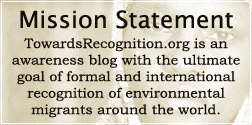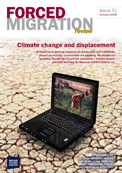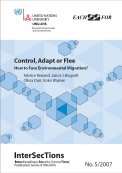Posted by Dan DaSilva on September 20th, 2013 | 
The original article below is written by guest blogger for Towards Recognition Joana Armie
The human history says we were nomadic in the-moving place to place-the Bible has all reference of the way the people were moving in the wilderness in search of food and water. Right for identity-passport contact number. The passport-having a passport or other relevant document that will help to identify and come under the headcount of statistics. The migrants may or may not have a valid passport of the country of origin and it is the first and foremost duty and right of such persons to establish their identity by procuring a meaningful legal document from the country where they are staying as a migrant. The number will help identify the person thus the dignity of the human person is restored. Right to food and water-the human person should be given sufficient food to keep the body and soul intact, they have the right for food and water for survival.
Right to shelter-The migrants who have fled from their homes have the right for shelter and accommodation. The adverse climatic conditions in the new region demands a reasonable shelter if not a home with all basic amenities at least with minimum facilities to stay in a human condition. Right to health care and medicines-most of the migrants are from countries affected by war and famine and hence their basic heath may not be sound. Especially the women and children need health care. Proper medication will help the migrants to escape from epidemics and contagious sickness they may affect them in the new environment they are forced to accept as their living place.
Right to clothing –Man need to be protected from the environment and more so the dignity of the human person is the first and foremost right of any human person and in the case of the Migrants it is also a valid right to be a human person even in this adversity and difficulty. Right for legal Aid-The Migrants should be provided legal assistance under the international norms so as to fight their rights at the other end that is the country of origin and after all they may like to go back to their home land or in some cases forcefully deported to their country of origin.
Right to marriage and child birth-The migrants like any of the communities will have to have freedom of family life and child birth. The international law should find sufficient provisions to marriage of the Migrants. Right to have services of worship and prayer-this is considered to be a right to worship and prayer.
A migrant group may find time and space for worship in whatever form permitted in the country of stay. Right for education-the children of the school going age have the write to education at the primary level. If they want they can even persue their higher studies in whatever country they want if it is affordable. The right to travel with in the country of migration and to attend to meetings related to Migrants with in the country. The Migrants need to be treated with all human dignity and these Rights will definitely ensure this.
Posted by Kayly Ober on June 6th, 2012 | 
If you’re in the mood for a highly technical, legal read, the Columbian Journal of Environmental Law published “Sea Level Rise and the Freely Associated States: Addressing Environmental Migration Under the Compacts of Free Association” in vol. 37, no. 1.
From the introduction:
Few issues in the climate change debate today are as compelling or as contested as sea level rise. In the coming century, rising sea levels have the potential to submerge coastal regions and displace millions of people. While countries throughout the world will be affected, the Intergovernmental Panel on Climate Change (IPCC)
has identified small island nations as “especially vulnerable.” Because these nations are physically small and often have high population densities, underdeveloped economies, and scarce resources, many will have difficulty adapting to the effects of sea level rise and any associated population displacement. Some island nations could disappear completely, in which case entire national populations would be forced to relocate abroad.
Three small island nations vulnerable to sea level rise—the Republic of the Marshall Islands (the RMI), the Federated States of Micronesia (the FSM), and the Republic of Palau (Palau)—have relationships of “free association” with the United States. These Freely Associated States (FAS) are sovereign nations that have negotiated Compacts of Free Association with the United States, under which the U.S. provides the states with certain types of assistance and has full “authority and responsibility . . . for security and defense matters” relating to the states. While the central provisions of the Compacts address foreign assistance and defense, the Compacts are comprehensive in scope and fully define the relationships between the U.S. and
the FAS. This Note focuses on the immigration provisions of the Compacts, which give citizens of the FAS the right to enter, work, and live in the U.S. with few restrictions. Although these provisions were originally negotiated long before rising sea levels threatened the habitability of islands within the FAS, because current refugee and immigration laws do not adequately address human displacement associated with climate change, these provisions could inadvertently serve as one of the few immigration options open to citizens of the FAS who choose to, or are forced to, relocate abroad due to rising sea levels.
This Note discusses whether the immigration provisions of the Compacts will provide an adequate framework to address migration from the FAS connected with sea level rise. Part I of this Note describes the relationship between the U.S. and the FAS under the Compacts of Free Association, focusing on the rights of citizens of the FAS to enter, work, and live in the United States. Part II describes the vulnerability of the FAS to sea level rise and asserts that the current international legal frameworks applicable to refugees and immigrants will offer little protection to citizens of the FAS displaced by rising sea levels. Part III analyzes the immigration provisions of the Compacts as a
mechanism to address migration from the FAS connected with sea level rise. It argues that the immigration provisions will not provide an adequate solution to permanent or large-scale population displacement, but they could form part of an adaptive response to the climate change pressures that threaten the future of these island nations. Any adaptive response to climate change in the FAS, however, must prioritize the rights of the citizens of the FAS to remain in their countries under safe and sustainable conditions.
Posted by Kayly Ober on June 6th, 2012 | 
The research project micle – “Migration, Climate and Environmental Changes in the Sahel” – investigates the social-ecological conditions of population movements in Mali and Senegal. The overall goal of the project is to contribute to a better understanding of the complex relationships between (climate-related) environmental changes and migration.
Sahelian countries are expected to be amongst the regions most affected by impacts of climate change such as hotter and drier climates, oscillations in precipitation patterns and land degradation. The UNDP estimates that a considerable amount of drylands in sub-Saharan Africa could experience severe droughts. Countries like Senegal and Mali could lose up to 50 percent of their agricultural capacity. The Sahel and particularly West Africa has, on the other hand, a long history of population movements and represents a multitude of migration patterns and trajectories. For a few years now, internal and international migrations have increased in both countries. However, causes and motives for migration are manifold, and the relationship between ecosystem changes and population mobility is complex. Therefore, an inter- and transdisciplinary research approach is needed.
The first micle project working paper summarizes the current status of selected topics that are analyzed within the project.
- a representation of the current scientific debate on climate change,
environment and migration
- general climate and environmental conditions in the Sahel, with special attention to countries of Mali and Senegal
- changing patterns of migration to and from West Africa
- the main policies of both countries (internationally, regionally and nationally) in terms of migration
- An overview of the conceptual approach of the project Micle
Background
In all likelihood, will be among the countries of the Sahel countries to those who are most affected by the impacts of climate change. These include hotter and drier climatic conditions, changes in precipitation patterns and land degradation. Migration, both within the country and internationally, is growing in both countries. However, the causes and motives for migration of various kinds, and the relationship between changes in the ecosystem and population mobility is complex. Environmental changes can not be considered separately, but when dealing with social, cultural, economic and political factors are seen to influence the overall migration.
Posted by Kayly Ober on May 18th, 2012 | 
(Brookings Institution) May 14, 2012 – Displacement caused by conflict and human rights violations is typically resolved through the pursuit of three “durable solutions”: local integration, resettlement or voluntary return. It has often been assumed that durable solutions mark the end of mobility for refugees and internally displaced persons (IDPs). However, in recent years it has become clear that this assumption needs to be reconsidered. Even after the situations that forced them from their homes have been resolved, many former refugees and IDPs remain “on the move,” making choices that subvert the standard durable solutions framework. For instance, they may return periodically to their communities of origin while maintaining permanent residence in a resettlement country, or they may become migrant workers in other countries. The traditional trio of durable solutions may also need to be reconsidered in light of the challenges posed by climate change. In the following piece, we provide some brief reflections on the ways in which displacement linked to climate change may test some of the principles underpinning the durable solutions framework, and necessitate new thinking about solutions to displacement.
Already, the systems in place for supporting solutions to displacement are hard pressed to deal with refugees and IDPs uprooted by persecution and other forms of serious harm. Many wait decades to access a safe and dignified solution to their displacement, due to factors such as lack of political support for local integration, insufficient resettlement opportunities, and persistent insecurity and under-development in return communities. The pressures on the existing solutions framework are likely to increase as the effects of climate change start to influence people’s decisions to move away from their homes. While it is difficult to attribute movement solely to the impacts of climate change, it is clear that increasing numbers of people are already being displaced by disasters, such as major hurricanes and floods, whose severity and frequency are likely to increase with global warming. Slower-onset environmental processes, such as desertification, are also likely to be exacerbated by changes to the climate. Researchers expect that the majority of those uprooted by climate change-related phenomena will become internally displaced. A much smaller number of people, such as those from small island states, may be compelled to seek shelter in other countries. Since they will not qualify as refugees under international law, it is an open question whether the discourse and logic of “durable solutions” will be applied to them. In our view, it may prove more useful to focus on facilitating managed migration opportunities for those who cannot remain in their homes. This applies both to internal movement (for example, by national governments developing planned rural–urban migration schemes in consultation with affected communities), as well to international movement (for example, through the establishment of “merits-based migration” programs for citizens of small island states who wish to move preemptively, as advocated by the President of Kiribati). Indeed, the possibility of planning managed migration opportunities in advance of displacement linked to the effects of climate change sets these movements apart from many forced migration flows sparked by conflict and human rights abuses. For the present, however, it is useful to consider the ways in which the current durable solutions framework may be challenged by both internal displacement and cross-border migration associated with climate change.
Continue reading this post »
Posted by Kayly Ober on May 10th, 2012 | 
The International Food Policy Research Institute released a brief on “Environmental Migrants:
A Myth?”
From their website:
Environmental migration has been the subject of lively debate in recent years. Recent International Food Policy Research Institute (IFPRI) research lets us put this debate into perspective. Microlevel evidence has improved our understanding of how climate affects individual and household decisions to migrate
over time in African and Asian countries. Macrolevel analyses help us assess whether such country-specific evidence may be systematic enough to constitute a global phenomenon.
This brief reviews recent evidence, examines main research challenges in identifying migration–climate links and discusses the policy options for formalizing migration as an adaptation mechanism to climate change.
To read the full brief, click here.
Posted by Kayly Ober on May 8th, 2012 | 
As part of IOM’s annual International Dialogue on Migration – dedicated in 2011 to the theme The Future of Migration: Building Capacities for Change – the IOM membership selected the topic “Climate Change, Environmental Degradation and Migration” as the focus of a workshop in Geneva, Switzerland on 29 and 30 March 2011. The workshop identified some of the main areas in which governments and institutions may need to reinforce their capacities to manage the complex interactions between climate change and environmental degradation and human mobility. The workshop was framed by the notion that a comprehensive approach to managing environmental migration would aim to minimize to the extent possible forced migration resulting from environmental factors; where forced migration does occur, to ensure assistance and protection for those affected and seek durable solutions to their situation; and, lastly, to facilitate the role of migration as an adaptation strategy to climate change.
The following four main areas for capacity-building received particular emphasis during the workshop: 1) Knowledge base and research capacity on environmental migration; 2) Capacities to devise solid legal and institutional frameworks to ensure the protection of those on the move for environmental reasons; 3) Capacities for comprehensive migration management policies to
tackle the multifaceted impacts of climate change and environmental degradation on human mobility; 4) Technical and operational capacities to support vulnerable populations and promote effective migration management in the context of environmental changes.
Recently, the IOM released dialogue number 18 “Climate Change, Environmental Degradation, and Migration” based on these workshop results. The full report can be found here.
Table of Contents
- Chair’s Summary
- Workshop Report
- Introduction
- Scope and purpose of the workshop
- Deliberations and recommendations of the workshop
- Conclusion
- Migrant’s Voice
- Agenda and Background Paper
- Annex
- Useful definitions
- Bibliography
- List of selected international legal and policy frameworks
|
|



